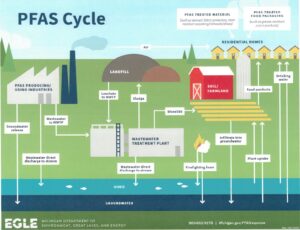Perfluorooctane Sulfonate, or PFOS for common language, exists in 37 counties in Michigan. A PFOS contamination level has not been exactly determined for the maximum contaminant level (MCL). Most states are regulating around the mark of 14 parts per trillion. That’s about the equivalent of six contaminated water drops in an Olympic size swimming pool!
PFOS is one of thousands of different Polyfluoroalkyl Substances or PFAS chemicals. Let’s learn about the issues of contamination.
The PFAS Cycle

As we progress with the ability to test down to levels that were never dreamed of before, the issue will be, is there enough contaminant in the water to cause a health risk?
Scientists are still learning about the health effects of exposures to mixtures of PFAS. Although more research is needed, some studies in people have shown that certain
Potential PFAS Issues
PFAS May:
• Lower a woman’s chance of getting pregnant
• Increase the chance of high blood pressure in pregnant women
• Increase the chance of thyroid disease
• Increase cholesterol levels
• Change immune response
• Increase the chance of cancer, especially kidney and testicular cancers
How to Treat PFOS Contamination
The best way to treat PFOS Contamination is with Activated Carbon Filtration followed by Reverse Osmosis (which also removes most other contaminants) with post carbon for drinking water. It starts with proper testing (a critical step) and how the grab sample is acquired. The process is expensive with most labs charging $300 – $600 for a certified test. Then a plan for treatment is proposed based on the amount of contaminants in the raw water.
The System will be designed and installed using NSF, ANSI, and WQA gold standard guidelines. Certifications apply to filters and systems and deliver a high drinking water standards.
Flier’s will work with EGLE or other state agencies to help you determine acceptable treatment methods for your scenario. Contact us with any assistance you need.





